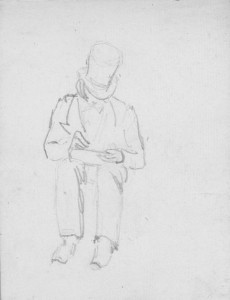Leopold Schlösser (Berlin ? - 1836 Düsseldorf)
Self-Portrait, c.1830
Pencil on paper, 9.5 x 6.7 cm
Provenance:
Professor Dr. Brinckmann, Cologne
Private collection, Munich
Literature:
Hans Geller, Die Bildnisse der deutschen Künstler in Rom 1800-1830, Berlin 1952,
p. 101, no. 1256, fig. 491
This delicate self-portrait drawing by the young painter Leopold Schlösser was executed in the early 1830s soon after his return from a stay in Rome. Little is known about Schlösser’s life and work. Records show that he visited Italy with Carl Blechen (1798-1840) in the years 1828-9. The refined draughtsmanship shows Schlösser’s indebtedness to the art of the Nazarenes. He would almost certainly have come into contact with the group during his stay in Rome. On his return from Italy he enrolled at the Düsseldorf Academy of Art in 1832, where he studied under Wilhelm Schadow (1789-1862) and Johann Wilhelm Schirmer (1807-1863).[1]
In September 1828, Blechen set out from Berlin on a one-year visit to Italy.[2] His travelling companion was his friend Leopold Schlösser, who had been living in Berlin and very probably met Blechen as a student at the Berlin Academy.[3] They visited Venice and made stops in central Italy, Rome and Naples. On study tours like these it was not unusual to meet like-minded compatriots – in Rome, they shared lodgings with the landscape painters Joseph Anton Koch and Johann Christian Reinhart. On Capri they met August Kopisch, Christian Friedrich Ferdinand Thöming and Wilhelm Ahlborn.[4] Blechen and Schlösser set off on the return journey to Berlin on 20 November 1829. Blechen was named professor at the Berlin Academy in 1831.

Fig. 1 Carl Blechen, A Man Sketching, pencil on paper, 10 x 13 cm, from the ‘Second Naples Sketchbook’ (Sketchbook IV), fol. 10r, 1828-9, RV 1047, Braunschweig, Herzog Anton Ulrich-Museum, Kunstmuseum des Landes Niedersachsen (inv. ZL 81/5793)
Blechen’s passport documents the various stages of the journey with Schlösser and he left a large body of travel sketches and studies which provide a visual record of their peregrinations. He also compiled a travel journal on his return to Berlin. Schlösser is mentioned in Blechen’s notebooks as Schloßer and under the abbreviation Schl. Blechen’s sketchbooks contain a number of single-figure studies and portraits, one of which depicts a man sketching (Fig. 1). It is not unreasonable to conjecture that Schlösser is the artist depicted. When Schlösser enrolled at the Düsseldorf Academy of Art in 1832, the Academy entertained close ties to the Berlin Academy. Schadow, a native of Berlin, had succeeded Peter von Cornelius – whom he knew from their meetings in Rome in 1811-12 – in 1826 as director of the Düsseldorf Academy. Schadow’s greatest achievement as director was to realign academy structures. His integration of the landscape genre into the painting class transformed the Academy into a hub of new artistic ideas, attracting many of his talented former pupils to Düsseldorf, among them Eduard Bendemann and Carl Friedrich Lessing.
Very little is known about Schlösser’s life and there is no clear evidence of his age when he died in 1836, still a young man and a student at the Düsseldorf Academy. Only a handful of his works are recorded but at least one important sale is documented. This was the sale of a landscape titled Abendlandschaft, die Fischerei am See (Evening Landscape – a Fishery on a Lake) executed in 1833. The buyer was Prince Friedrich Wilhelm Ludwig of Prussia (1794-1863),[5] nephew of Friedrich Wilhelm III of Prussia. The Prince was an active patron of the arts in Düsseldorf. He supported academy activities by regularly commissioning work and purchasing paintings. The Düsseldorf Academy was to make a significant contribution to the development of Romantic painting in Germany.[6]
[1] See Atanazy Raczyński, ‛Düsseldorf und das Rheinland’ in id., Geschichte der neueren deutschen Kunst, I, (trans. into German Friedrich Heinrich von der Hagen), Berlin 1836, p. 117 and p. 254. [2] See Friederike Sack, Carl Blechens Landschaften – Untersuchungen zur theoretischen und technischen Werkgenese, Diss., LMU, Munich 2007, p. 181 ff. [3] See Ulrich Thieme and Felix Becker, Allgemeines Lexikon der bildenden Künstler von der Antike bis zur Gegenwart, XXX, Leipzig 1936, p. 115. [4] Rosa von Schulenberg (ed.), Carl Blechen. Vom Licht gezeichnet. Das Amalfi-Skizzenbuch aus der Kunstsammlung der Akademie der Künste, Berlin, exhib. cat., Hamburger Kunsthalle; Berlin, Nationalgalerie, Alte Staatliche Museen zu Berlin; Rome, Casa di Goethe, Berlin 2009, pp. 37-9. [5] See Jacob Höggerath (ed.), Rheinische Provincial-Blätter für alle Stände, III, Cologne 1835, p. 197, no. 111. For details of two further works by Schlösser see Höggerath, loc. cit.: Gebirgslandschaft mit Wölfel (1843), Graf von Bismarck von Bohlen, Berlin. Landschaft, See mit Fichtengehölz umgeben (1835). [6] See Ernst Dietrich Baron von Mirbach, Prinz Friedrich von Preußen: ein Wegbereiter der Romantik am Rhein, Cologne 2006.

